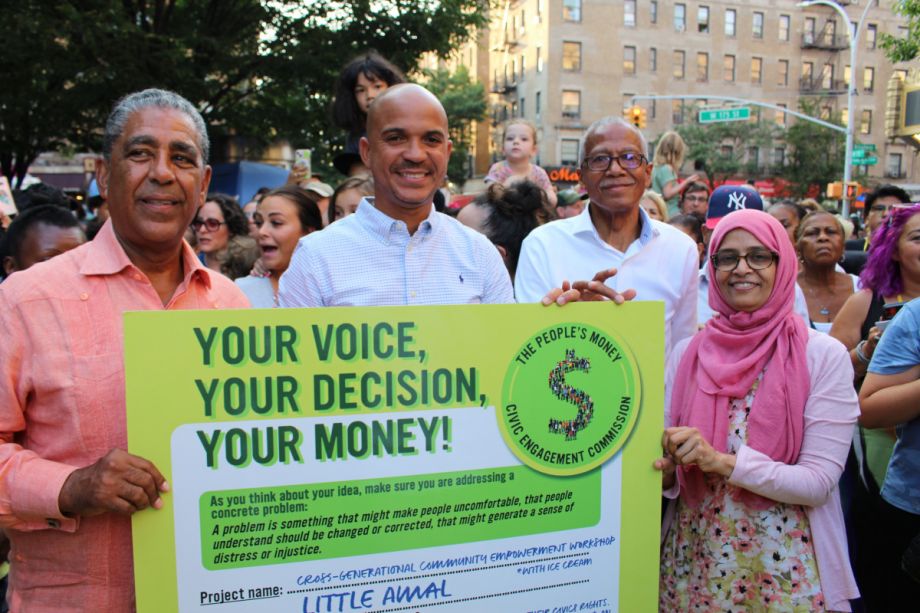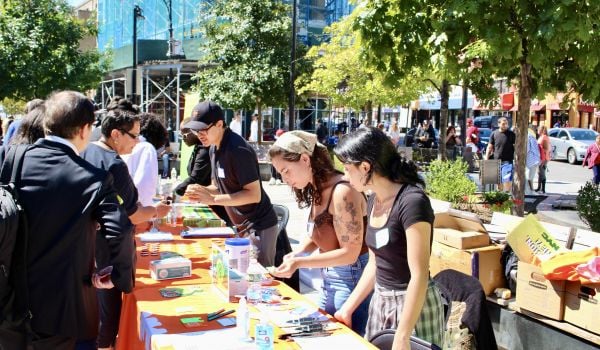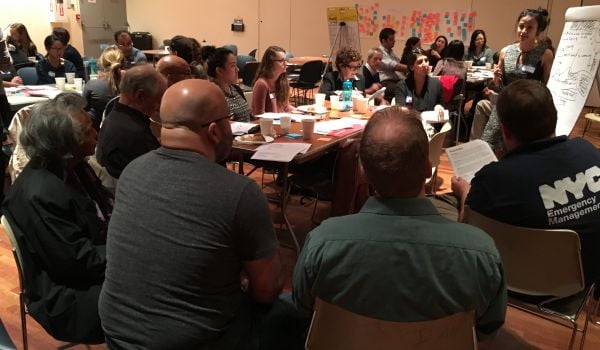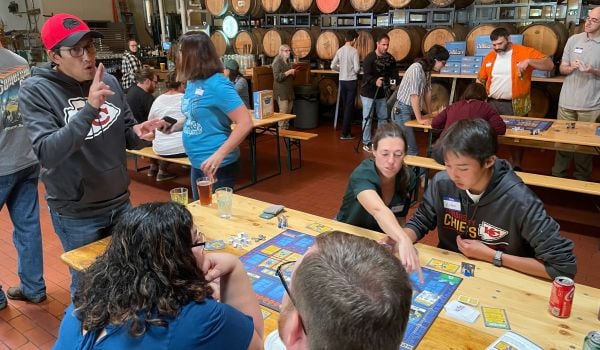A decade after four New York City councilmembers introduced participatory budgeting to their districts, and four years after voters approved a mandate to formalize and expand the process, the community engagement process that gives residents decision-making power over public money has officially launched citywide.
The Civic Engagement Commission, tasked with overseeing the expansion and implementation of participatory budgeting, engaged over 12,000 New Yorkers this fall and collected 4,139 of their ideas. Now, the commission is launching the city’s first-ever borough assembly committees, who will help determine which ideas make it to the ballots this May. A total of $5 million will be distributed to chosen projects.
“Government’s job is to respond to what people are saying and what they need,” says Sarah Sayeed, chair and executive director of the Civic Engagement Commission. “This is a process that does that. We’re developing tools and strategies to bridge the knowledge gaps around the city budget that are exciting, interesting, and hopefully makes people want to learn more.”
Participatory budgeting, in which governments allocate a slice of public funds to be spent in accordance with residents’ desires, began in Brazil in the ‘80s. It reached the U.S. in 2009, when Chicago’s 49th ward held the country’s first participatory budgeting vote. Since then, it’s been taken up by U.S. cities from Denver to Durham.
When participatory budgeting was first introduced in New York City in 2011, it was up to City Council members to offer the option to their constituents. Still, a blueprint emerged: communities came up with funding proposals for their district and held a vote. Voters had to be residents within the designated ZIP code and be at least 11 years old.
In 2018, New York City voters approved the creation of the Civic Engagement Commission, specifically tasked to expand participatory budgeting citywide. The commission’s first pilot, “It’s Our Money,” engaged over 2,000 young people across the city to fund five community-based projects at $20,000 each.
Between fall 2021 and early 2022, the Civic Engagement Commission facilitated a second pilot, this time engaging 33 priority neighborhoods identified by the city’s Taskforce On Racial Inclusion And Equity as disproportionately impacted by the pandemic. Community organizations working in those neighborhoods led engagement, visioning sessions and voting. That summer the city distributed $1.3 million to 33 projects that included a youth soccer tournament in the Bronx and culturally-based mental health workshops in Bushwick, Brooklyn.
By fall of 2022, the Civic Engagement Commission was ready to take the process citywide.
The pilot had been instructive for the commission. “One important lesson was that people really valued the process of the city asking their opinion as to what mattered, and they valued the opportunity to contribute ideas,” Sayeed says. “People wanted more of that.”
The Civic Engagement Commission grew to meet the need. The commission hired a manager to oversee the process, plus four coordinators to work with community-based organizations. Increased funding allowed the commission to hire 82 community organizations to facilitate “idea generation sessions.”
The commission developed tools for the idea generation sessions based on insights from the pilot. There were in-person and digital facilitation guides, which introduced concepts like direct democracy and participatory democracy. Trivia cards posed questions about the city budget, like “How much do you think the city spends on arts and culture?” A budget poster clearly broke down how the city allocates funding. Stickers allowed participants to mark up the poster with their own priorities.
“It was an interactive way for participants to engage and ask questions about the budget, interact with each other, and start to name their own priorities,” says Wendy Trull, senior advisor for the commission.
Between September and November, community organizations hosted over 500 idea generation sessions across the five boroughs. Fund for Public Housing partnered with the city’s public housing agency, NYCHA, local nonprofit organizations and public housing tenant leaders to host 12 sessions across the city. (There are 335 public housing developments across all five boroughs, housing 500,000 New Yorkers.)
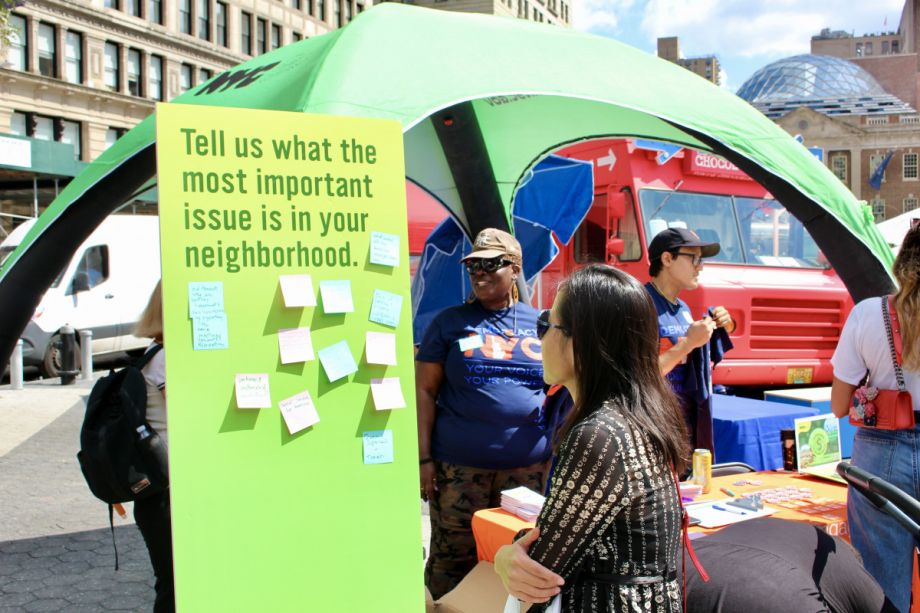
(Photo courtesy New York City Civic Engagement Commission)
Fund for Public Housing hosted one session at the New York Aquarium on Coney Island, offering a free aquarium ticket to participants. Another on Staten Island doubled as a kid-friendly Halloween party.
“Most residents had not participated in something like this in the past,” says Alex Zablocki, director of the fund. “I facilitated most of the sessions and it was really exciting to see people learn about the budget and feel empowered about the process on how to solve community problems.”
Three major priorities were programs, job training and resources for youth in public housing, intergenerational programs that brought youth and elders together, and community cleanliness.
Brooklyn Level Up hosted six sessions in two neighborhoods it serves, Flatbush and East Flatbush. With the budget provided by the Civic Engagement Commission, the organization hired a local caterer to provide food at each event and paid interns from Brooklyn College to help facilitate.
“The trivia cards really worked, because it allowed people to gamify the learning process,” Brooklyn Level Up co-founder Allyson Martinez says of the engagement tools. Priorities that emerged were technology training for seniors, intergenerational skills-building programming in areas such as home repair, medical training and vocational trades, mental health and wellness resources, and more exposure to the arts.
“These are things that other communities might take for granted but are not as readily available here,” explains Martinez. “People want programming that will help them stay and live in dignity here.”
Both Martinez and Zablocki say the sessions helped them set priorities within their own organization. Brooklyn Level Up is focused on establishing community land trusts. “Now we know the programming that is needed alongside the spaces we are trying to build,” Martinez says.
The Civic Engagement Commission found that top priorities were consistent across the city: “Hunger, youth, mental health and addressing gun violence,” according to Sayeed. The commission also distributed a feedback survey, finding that 90% of respondents learned something new about the city budget and over 85% wanted to stay involved in the process.
For this allocation of $5 million, $1.65 million will go to those 33 priority neighborhoods identified by the city’s Taskforce On Racial Inclusion And Equity as disproportionately impacted by the pandemic. The remaining $3.35 million will be spread across the five boroughs, based on the population of each borough and how many people live under the poverty line.
The Civic Engagement Commission is now establishing borough-based assembly committees who will select final proposals that will be voted on in May and June.
“We’re excited to pilot a deliberative process, in addition to this participatory process, in that we’re inviting people in to have a longer, more intense conversation in an assembly-type model,” says Trull. Residents who have applied will be selected by lottery.
This will be a year-long process in total. The Civic Engagement Commision feels the idea generation sessions were a promising first step to destigmatize the city budget, while educating and empowering residents through community engagement.
Still, this could be a blueprint to go even further. Josh Lerner is executive director of the global participatory budgeting hub People Powered and an early proponent for participatory budgeting in New York City.
“The biggest shortcoming of the program is the size … for a city with a $111 billion budget, and only $5 million being allocated, it’s embarrassing,” he says. “Especially now, when people are really hungry to have more of a meaningful say on issues that affect their lives.”
Lerner points to other cities like Paris, where participatory budgeting has radically shifted its budget priorities: “New York’s program is really the exception, not the norm, from an international perspective and I think it’s holding possibilities back.” Participatory budgeting, he adds, has the potential to meaningfully inform budgets across city agencies.
“We shouldn’t see this as a side program,” he says, “but an opportunity to really change how mainstream funding is allocated.”

Emily Nonko is a social justice and solutions-oriented reporter based in Brooklyn, New York. She covers a range of topics for Next City, including arts and culture, housing, movement building and transit.
Follow Emily .(JavaScript must be enabled to view this email address)

